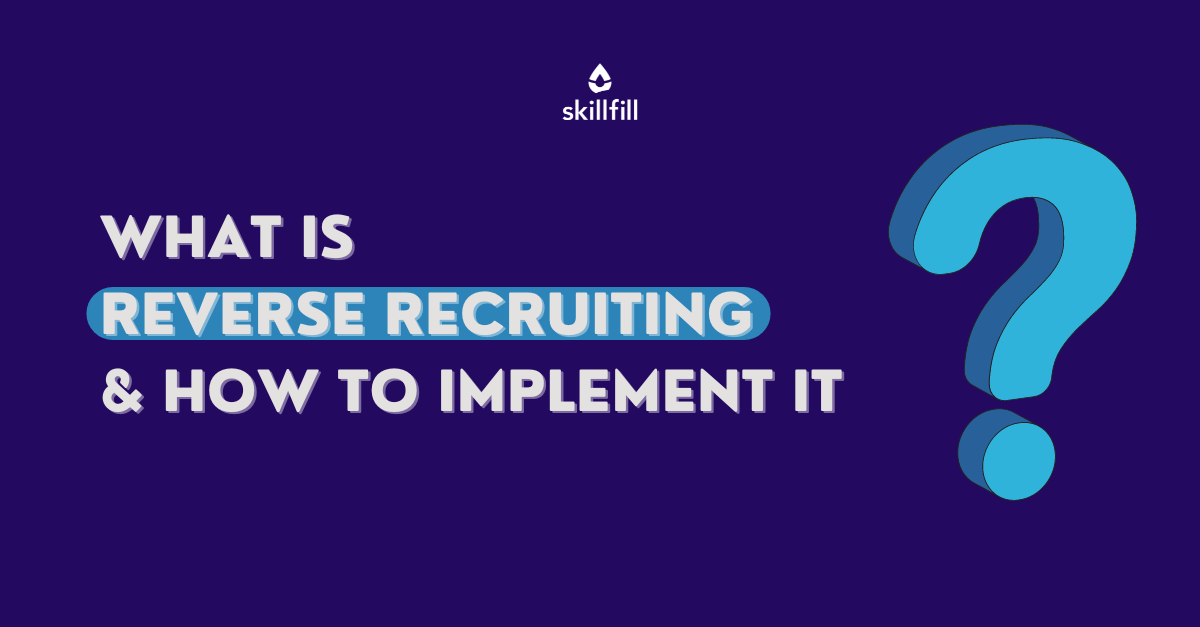Reinvent Your Hiring Process with Reverse Recruiting Methods
Reinvent Your Hiring Process with Reverse Recruiting Methods
Blog Article
Elevate Your Hiring Game With Strategic Reverse Recruiting Approaches
As the landscape of hiring evolves, companies are significantly transforming to cutting-edge techniques such as critical reverse recruiting to acquire a competitive side in protecting leading skill. This shift in attitude calls for a thoughtful reconsideration of how firms come close to the hiring procedure, concentrating on attracting passive candidates instead than entirely depending on energetic task applicants - reverse recruiting.
Understanding Calculated Opposite Recruiting
Strategically leveraging the principle of reverse recruiting can substantially improve your company's ability acquisition technique. By flipping the typical recruitment approach on its head, reverse recruiting entails proactively looking for and attracting passive prospects that may not be actively looking for brand-new chances. This aggressive approach permits companies to take advantage of a swimming pool of premium ability that might not be available through conventional work posts alone.
Understanding the ins and outs of tactical reverse recruiting is important for its successful implementation. It needs a deep understanding of the market landscape, competitor evaluation, and the specific ability that are in high need. reverse recruiting. By conducting complete study and leveraging market insights, companies can determine and involve with leading talent in a much more individualized and targeted way

Benefits of Reverse Hiring
Reverse recruiting supplies an one-of-a-kind technique to talent acquisition by proactively involving with passive candidates who might not be proactively looking for task opportunities. This approach enables firms to take advantage of a swimming pool of ability that conventional recruiting techniques might ignore. Among the key advantages of reverse recruiting is the capability to target candidates who are already used and satisfied in their present functions. These people are usually leading entertainers in their respective fields, bringing useful abilities and experience to the table.

Trick Components of Reverse Recruiting
Having checked out the benefits of reverse recruiting in targeting leading performers that are web content in their current duties, it is necessary to recognize the crucial parts that make this method effective in drawing in passive prospects. The initial crucial element is building a solid employer brand. Easy candidates are typically not actively seeking new chances, so having a favorable reputation as an employer can stimulate their interest. Leveraging social networks systems and company testimonial websites to display company culture and values can aid in this respect.
One more important component go to this website is customized outreach. Since passive candidates are not actively looking for tasks, common employment messages are likely to be forgotten. Customizing outreach efforts to highlight exactly how the certain skills and experiences of the candidate align with the business's requirements can substantially boost the possibilities of getting their focus.
In addition, promoting partnerships with passive candidates in time is important. On a regular basis engaging with them via networking events, sector meetings, and even periodic check-ins can help build rapport you can look here and depend on, making them a lot more responsive to prospective job opportunities in the future. By including these key components into reverse recruiting techniques, organizations can properly attract and work with top skill from the swimming pool of passive prospects.
Carrying Out Reverse Recruiting Strategies

Additionally, developing compelling company branding and showcasing a positive company culture can assist attract easy prospects and motivate them to think about new profession opportunities. Building a talent area or ability pipe can likewise be beneficial in supporting partnerships with passive prospects over time, maintaining them engaged and interested in possible future roles within the company. On the whole, applying reverse recruiting approaches calls for a positive and personalized technique to skill procurement, focusing on establishing meaningful connections with easy prospects to drive lasting employment success.
Gauging Success backwards Hiring
Reliable measurement of success in recruiting techniques requires a comprehensive examination of crucial efficiency indications and metrics to evaluate the impact and efficiency of skill purchase initiatives. In the context Click Here of reverse recruiting, specific metrics can supply important insights into the performance and performance of the technique. One vital metric is the top quality of prospects engaged via reverse recruiting networks. By gauging the conversion rate of passive candidates into active applicants or hires, organizations can assess the efficiency of their reverse recruiting efforts.
Additionally, tracking the time-to-fill statistics for settings filled up through reverse recruiting can supply beneficial information on the efficiency of the procedure. A shorter time-to-fill shows that the approach is drawing in certified prospects immediately. Monitoring retention prices among candidates hired through reverse techniques can give insights into the lasting success of the approach. High retention rates recommend that the prospects sourced through reverse recruiting are a great suitable for the company, contributing favorably to its total talent swimming pool. By assessing these essential metrics, organizations can efficiently determine the success of their reverse recruiting initiatives and make informed decisions to maximize their skill procurement techniques.
Verdict
Finally, strategic reverse recruiting provides an unique approach to employing that concentrates on drawing in leading ability through aggressive interaction and relationship-building. By leveraging this method, companies can get an affordable side in the skill market and boost their employment end results. It is important to comprehend the benefits, essential elements, and techniques of reverse recruiting to properly execute and determine success in this cutting-edge approach to working with.
Report this page